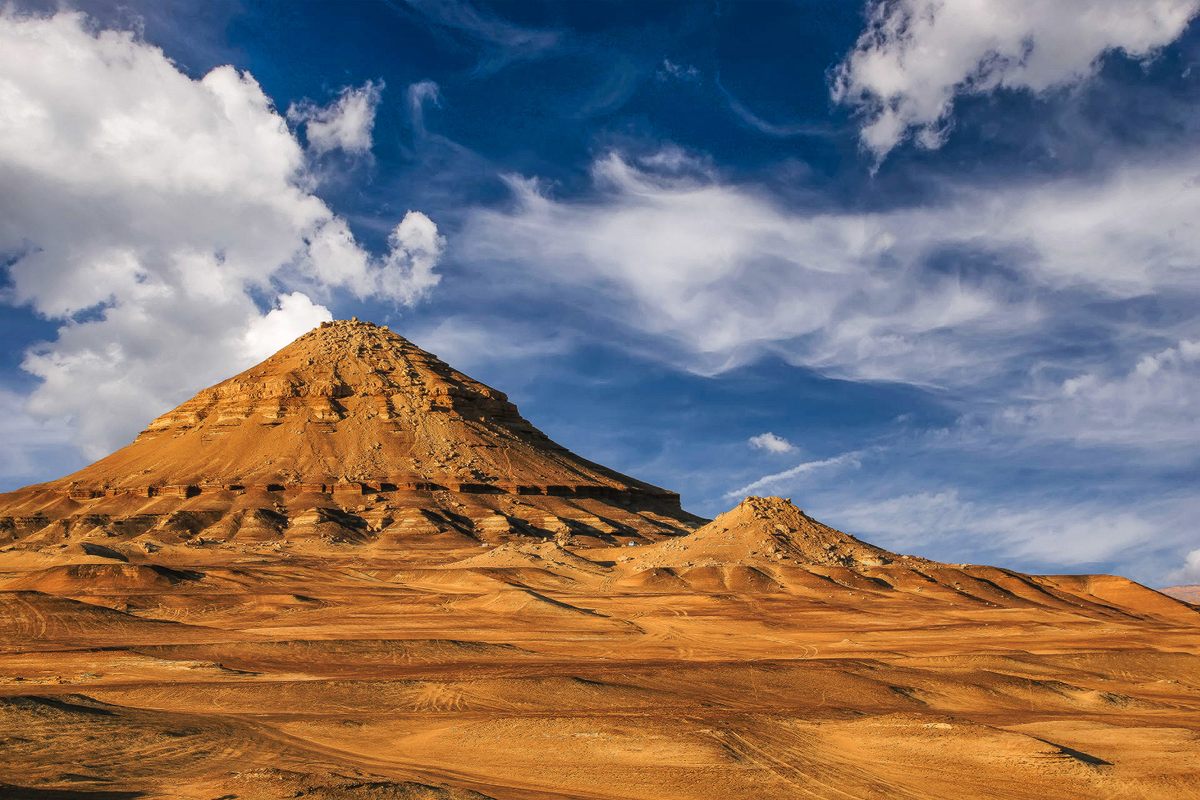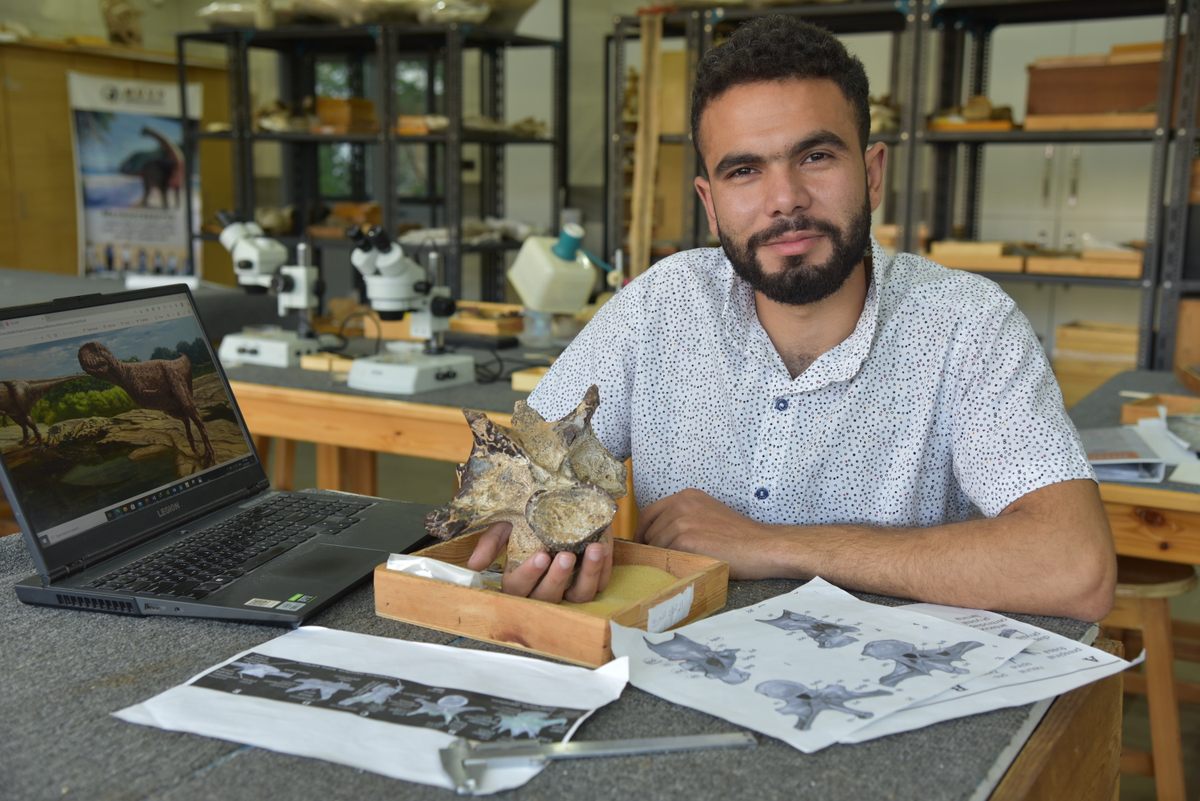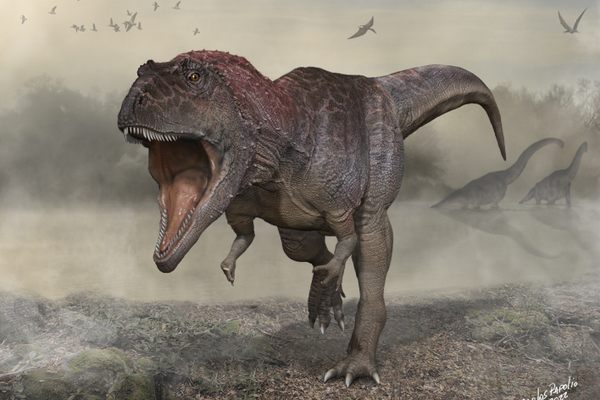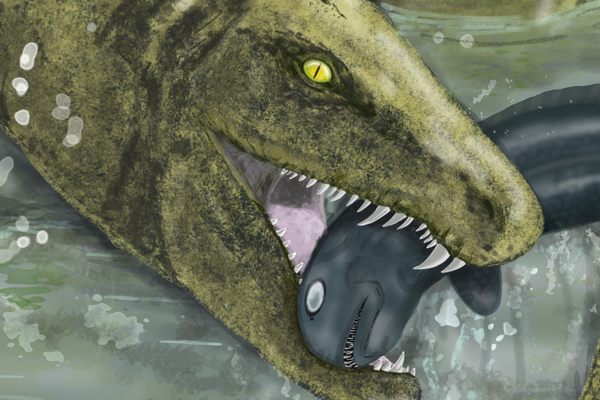In Egypt’s ‘Land of Death,’ Dinosaurs Were Supersized—and Hungry
Fossils unearthed in the Bahariya Oasis tell a story of giant predators hunting on land and in the water.
When Belal Salem visited the Bahariya Oasis for the first time, he felt he was on hallowed ground. Traveling deep into Egypt’s Western Desert to a sprawling valley dotted with guava and mango farms, Salem was retracing the steps taken more than a century earlier by German paleontologist Ernst Stromer, whose team had discovered some of the largest predatory dinosaurs ever found. The experience was overwhelming for Salem, a master’s student in vertebrate paleontology at Mansoura University in the country’s north. “I couldn’t feel my legs,” he says. Though he felt the weight of Stromer’s accomplishments, Salem was determined to make his own contribution to the field.
Salem got his chance recently when he and colleagues identified a new dinosaur from Bahariya based on a distinctive single bone. It took two years for the team to free the specimen, found in 2016, from surrounding sedimentary rock and iron. Once exposed, says Salem, the fossil was unmistakable: a vertebra from a theropod. This group includes all known carnivorous dinosaurs, from velociraptors to T. rex. The tall, thin shape of the neural arch—the ring of bone that held the spinal cord in place—established that the specimen belonged to a minibus-sized theropod called an abelisaurid, possibly a scavenger or small-game hunter. Salem and his coauthors described the discovery in a paper recently published in Royal Society Open Science.
The new find is the latest addition to a nightmarish roster of predators that terrorized the oasis almost 100 million years ago. Since Stromer’s historic expeditions into the valley, Bahariya has become a paleontological hotspot, yielding an unusual number of fossils of large theropod dinosaurs. As more details of the location’s geological and ecological past emerge, scientists are starting to understand why: Bahariya’s ancient environment was perfect for both supporting huge predators and preserving bones as fossils.

Stromer was the first paleontologist to conduct fieldwork in the area; his finds included Carcharodontosaurus and Bahariasaurus, large theropods which were comparable in size to their very distant cousin T. rex. Other specimens were utterly strange, such as Spinosaurus, a skilled swimmer with long jaws and a distinctive sail on its back—and at about 50 feet long, the largest predatory dinosaur ever known. The discoveries painted a terrifying picture of the oasis in the deep past. “I call it the land of death,” says Salem. “If you escaped from Bahariasaurus, you would find Carcharodontosaurus or Spinosaurus…and all of them are trying to eat.”
Stromer took the fossils back to Germany, but they were destroyed in a fire when the Allies bombed Munich in 1944. “The Bahariya dinosaurs went extinct twice in some ways,” says Matthew Lamanna, coauthor and a paleontologist at the Carnegie Museum of Natural History. The original specimens survive only in photos and illustrations, but subsequent discoveries by other paleontologists have helped to replace some of what was lost, and to understand the oasis as it was during the Cretaceous.
Bahariya had long puzzled scientists because of the conundrum, known as Stromer’s Riddle, raised by its fossil record: There was an abundance of large predators, but an apparent lack of large prey. What were all these monstrous meat-eaters hunting? In 2000, Lamanna was part of a team that helped answer that question with the discovery of Paralititan stromeri. The long-necked sauropod was about 85 feet long, making it one of the largest dinosaurs that ever lived—and, in Lamanna’s words, a “giant hamburger” for hungry theropods.
The environment that supported these massive animals had little in common with today’s desert oasis. About 100 million years ago, the area was a sweltering tropical coast, similar to modern Florida but with thick forests of ferns in place of mangroves. The abundant plant life in the oasis would have kept herbivore populations strong, ensuring plenty of food for the predators that made the oasis their hunting grounds.

Dinosaurs weren’t the only giants around. The area had a mix of freshwater and saltwater environments, says University of Pennsylvania paleontologist Barbara Grandstaff. The ecosystems were home to fish such as Bawitius, which grew as long as 10 feet and was covered in heavy enameled scales. These animals lived alongside crabs, crocodiles, and large turtles, and would have been prey for Spinosaurus, the only known aquatic dinosaur.
Some of the fossil fauna unearthed at Bahariya have been found at other sites, such as Morocco’s Kem Kem beds, which are about the same age. But Kem Kem appears to have had fast-flowing streams and rivers, which pulled carcasses apart and scattered the bones over a wide area, often leaving paleontologists with only a few fragments. What sets Bahariya apart, says Lamanna, are its relatively complete* skeletons, likely the result of more languid water movement through the area.
Layers of rock at Bahariya preserve only a few million years of its story, from the middle of the Cretaceous. The oldest rock from Bahariya represents a more terrestrial landscape but, says Lamanna, the new layers deposited above it show increasing evidence of a marine environment, indicating the gradual encroachment of a body of water called the Tethys Sea. Later, as the Cretaceous Period wore on, ancient Africa moved closer to what’s now Eurasia, and parts of the Tethys Sea transformed into the modern-day Mediterranean.
While the fossil record of North African dinosaurs is skimpy for the period following Bahariya’s reign of the giants, there is some evidence, says Lamanna, that at least one group of larger animals, the abelisaurids, survived in the area until around the time an asteroid brought the age of dinosaurs to an end some 66 million years ago.
Today, the oasis is changing again, as agriculture and other human activity expands in the once-empty desert, threatening fossil dig sites that Salem says his team is working to protect. After all, it’s almost certain that, like the recently described abelisaurid, there are more monsters buried at Bahariya, waiting to be found.
*Correction: This article previously stated that fossil skeletons from Bahariya Oasis are nearly complete. The skeletons are more complete than fossils of similar species found at other sites, but, according to Lamanna, they are still “incomplete enough to render all of these animals mysterious to at least some degree.”























Follow us on Twitter to get the latest on the world's hidden wonders.
Like us on Facebook to get the latest on the world's hidden wonders.
Follow us on Twitter Like us on Facebook